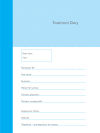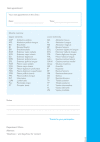Treatment diary for botulinum toxin spasticity treatment: a pilot study
- PMID: 28225535
- PMCID: PMC5414540
- DOI: 10.1097/MRR.0000000000000221
Treatment diary for botulinum toxin spasticity treatment: a pilot study
Abstract
The aim of this study is to develop a treatment diary for patients receiving spasticity treatment including botulinum toxin injection and physiotherapy and/or occupational therapy. The diary focuses on problems triggered by skeletal muscle overactivity; agreed goals for treatment and the patient's self-evaluation of achievement on the Goal Attainment Scale; which skeletal muscles were injected; physiotherapists' and occupational therapists' evaluation of the patients' achievement of objectives on the Goal Attainment Scale; and proposals for optimization of treatment and changing goals. The evaluation included a satisfaction questionnaire and the WHO-QoL BREF and WHO-5 well-being score. Overall, 10 patients were enrolled in the pilot study. The patients were generally satisfied with the diary, found that it involved them more in their treatment and made it easier to set personal goals, and found it worth the time spent using it. However, no clear advantage in relation to their quality of life (WHO-QoL BREF and WHO-5 well-being score) was reported.
Similar articles
-
[Botulinum toxin treatment of hip adductor spasticity in multiple sclerosis].Wien Klin Wochenschr. 2001;113 Suppl 4:20-4. Wien Klin Wochenschr. 2001. PMID: 15506048 Review. German.
-
Early physiotherapy after injection of botulinum toxin increases the beneficial effects on spasticity in patients with multiple sclerosis.Clin Rehabil. 2007 Apr;21(4):331-7. doi: 10.1177/0269215507072772. Clin Rehabil. 2007. PMID: 17613573 Clinical Trial.
-
Serial injection of botulinum toxin for muscle imbalance due to regional spasticity in the upper limb.Disabil Rehabil. 2007 Dec 15;29(23):1806-12. doi: 10.1080/09638280701568205. Disabil Rehabil. 2007. PMID: 18033605 Review.
-
More than a black box of rehabilitation: Characterizing therapy programmes following botulinum toxin injections for spasticity in adults with stroke.J Rehabil Med. 2016 Apr 28;48(5):426-34. doi: 10.2340/16501977-2085. J Rehabil Med. 2016. PMID: 27097568
-
Efficacy of therapeutic ultrasound and transcutaneous electrical nerve stimulation compared with botulinum toxin type A in the treatment of spastic equinus in adults with chronic stroke: a pilot randomized controlled trial.Top Stroke Rehabil. 2014;21 Suppl 1:S8-16. doi: 10.1310/tsr21S1-S8. Top Stroke Rehabil. 2014. PMID: 24722047 Clinical Trial.
Cited by
-
What is well-being? A scoping review of the conceptual and operational definitions of occupational well-being.J Clin Transl Sci. 2023 Oct 16;7(1):e227. doi: 10.1017/cts.2023.648. eCollection 2023. J Clin Transl Sci. 2023. PMID: 38028344 Free PMC article.
-
Upper limb robotic assessment: Pilot study comparing velocity dependent resistance in individuals with acquired brain injury to healthy controls.J Rehabil Assist Technol Eng. 2020 Dec 4;7:2055668320929535. doi: 10.1177/2055668320929535. eCollection 2020 Jan-Dec. J Rehabil Assist Technol Eng. 2020. PMID: 33329901 Free PMC article.
References
-
- Bakheit AM, Zakine B, Maisonobe P, Aymard C, Fhedoroff K, Hefter H, et al. (2010). The profile of patients and current practice of treatment of upper limb muscle spasticity with botulinum toxin type A: an international survey. Int J Rehabil Res 33:199–204. - PubMed
-
- Barmettler G, Brawn J, Maleki N, Scrivani S, Burstein R, Becerra L, Borsook D. (2015). A new electronic diary tool for mapping and tracking spatial and temporal head pain patterns in migraine. Cephalalgia 35:417–425. - PubMed
-
- Biering-Sørensen F, Alexander MS, Burns S, Charlifue S, Devivo M, Dietz V, et al. (2011). Recommendations for translation and reliability testing of international spinal cord injury data sets. Spinal Cord 49:357–360. - PubMed
-
- Cobabe MM, Sessler DI, Nowacki AS, O’Rourke C, Andrews N, Foldvary-Schaefer N. (2015). Impact of sleep duration on seizure frequency in adults with epilepsy: a sleep diary study. Epilepsy Behav 43:143–148. - PubMed
MeSH terms
Substances
LinkOut - more resources
Full Text Sources
Other Literature Sources










